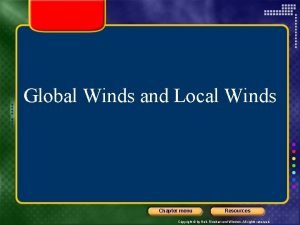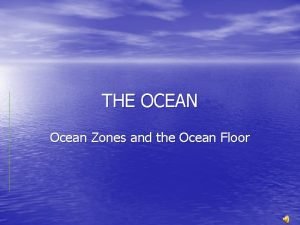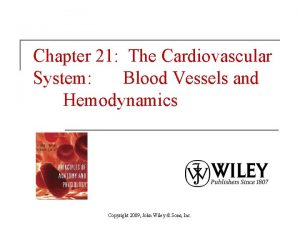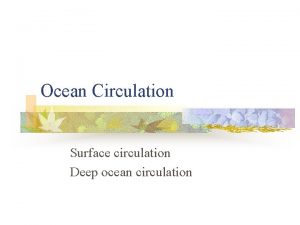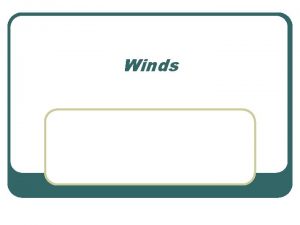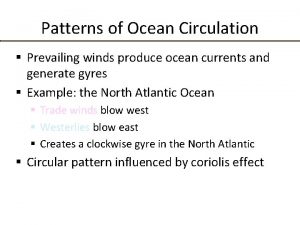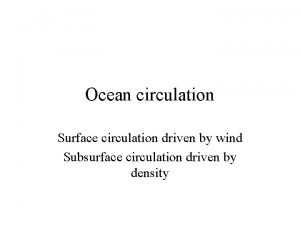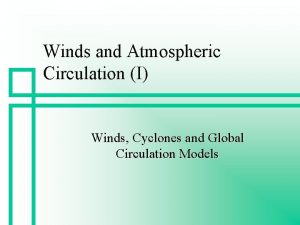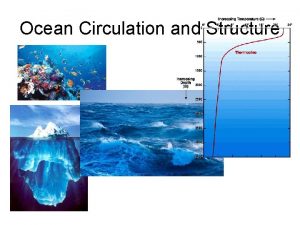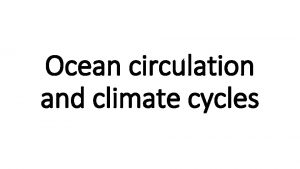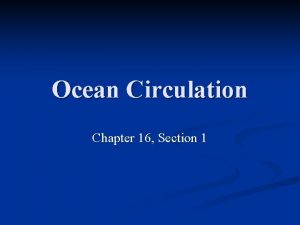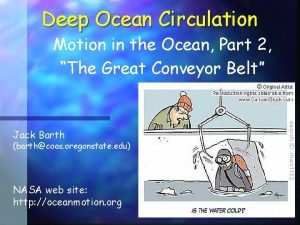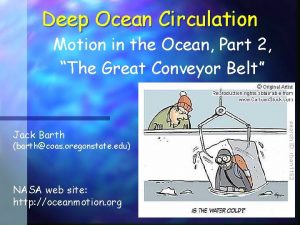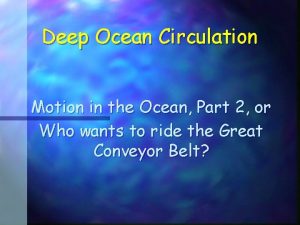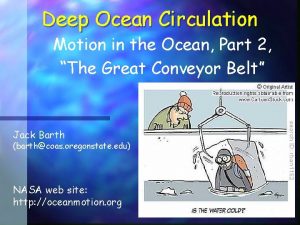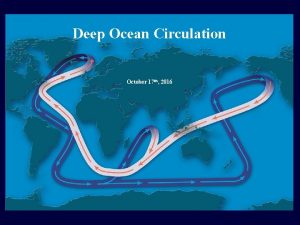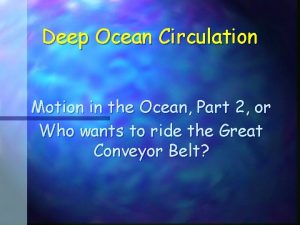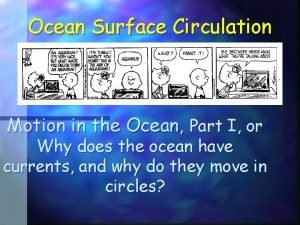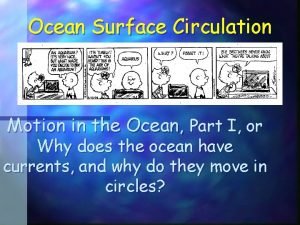Chapter 5 Surface Ocean Deep Ocean Circulation Winds




























- Slides: 28

Chapter 5 Surface Ocean/ Deep Ocean Circulation

Winds also cause large gyres (circular patterns) in the surface ocean…

Simplified geometry Ocean basin 60 Westerlies 30 0 Easterlies 30 Westerlies 60 Wind Continents

Ocean currents form large GYRES 60 30 60

http: //www. es. flinders. edu. au/~mattom/Intro. Oc/notes/figures/fig 2 a 2. html

Get downwelling at the centers of gyres low productivity

Phytoplankton patterns reveal circulation patterns: (Note the large gyres in Pacific Ocean) http: //www. ccpo. odu. edu/~arnoldo/ocean 405/globalcolor. gif

Major Ocean Surface Currents http: //www. geog. ouc. bc. ca/physgeog/contents/images/oceancurrents. gif

Gulf Stream Western edge of North Atlantic gyre Brings warm tropical waters north Transfers heat to Northern Europe Waters in the Gulf Stream are salty (because of evaporation)

http: //oceanexplorer. noaa. gov/explorations/islands 01/log/sep 22/media/atlantic_currents_600. jpg


What causes deep ocean circulation? • Surface ocean circulation can lead to density differences in surface water • What makes water dense? (Hint: 2 factors)

What makes water dense? • Cold temperatures* • High salt content Cold, salty waters sink below warm or fresher waters This drives circulation in deep waters *Except, curiously, below 4 o. C

Seawater density vs. T and S

Annual mean surface water salinity Units: Parts per thousand by mass http: //en. wikipedia. org/wiki/Seawater#Salinity

Seawater temperature vs. depth • On average, seawater temperature decreases with depth • This difference is less pronounced, though, at high latitudes http: //www. windows. ucar. edu/tour/link= /earth/Water/temp. html&edu=high

Seawater density vs. depth • On average, seawater density increases smoothly with depth • Slight differences exist, though, between different ocean basins http: //www. windows. ucar. edu/tour/link=/earth/ Water/density. html

http: //www. liv. ac. uk/~ric/

Salty waters from the Gulf Stream mix with cold waters in the North Atlantic


Salty waters from the Gulf Stream mix with cold waters in the North Atlantic The result is very cold and very salty water.

Salty waters from the Gulf Stream mix with cold waters in the North Atlantic The result is very cold and very salty water. This North Atlantic water sinks, and begins to move along the bottom of the Atlantic Ocean.

Salty waters from the Gulf Stream mix with cold waters in the North Atlantic The result is very cold and very salty water. This North Atlantic water sinks, and begins to move along the bottom of the Atlantic Ocean. Eventually it warms, and returns to the surface, creating a return flow.

The Atlantic Conveyor • Because it is driven by differences in temperature and salinity, this is termed thermohaline circulation

Radiocarbon Age of Deep Water Ref: Broecker and Peng, Tracers in the Sea (1982), p. 269

How Carbon-14 is made • 14 N: 7 p, 7 n • 14 C: 6 p, 8 n • C-14 production: 14 N + n 14 C + p • C-14 decay: 14 C 14 N + e (Beta decay) http: //science. howstuffworks. com/carbon-141. htm

Preview of global warming/effect on thermohaline circulation • Question: Has the Atlantic Conveyor Belt ever shut down? – Answer: We think it did shut down for almost 1000 years at the end of the last Ice Age. This is called the Younger Dryas Period

• Question 2: Could this happen again in the relatively near future? – Answer: Maybe! Global warming causes increase in rainfall in the N. Atlantic surface water becomes fresher and, hence, less dense – This effect is augmented by runoff of glacial meltwater from Greenland – Thermohaline circulation shuts down about 75 years from now in some climate model simulations!
 Single circulation and double circulation
Single circulation and double circulation Single circulation and double circulation
Single circulation and double circulation Pulmonary arteriole
Pulmonary arteriole Local and global winds
Local and global winds Earth's rotation makes global winds curve this is called
Earth's rotation makes global winds curve this is called 6winds
6winds Global winds and local winds
Global winds and local winds Local winds and global winds
Local winds and global winds Slowing atlantic ocean circulation
Slowing atlantic ocean circulation Nekton include all animals that
Nekton include all animals that Deep asleep deep asleep it lies
Deep asleep deep asleep it lies Deep forest towards an alternative to deep neural networks
Deep forest towards an alternative to deep neural networks 深哉深哉耶穌的愛
深哉深哉耶穌的愛 A smooth, nearly flat region of the deep ocean floor
A smooth, nearly flat region of the deep ocean floor Deep valley on the ocean floor
Deep valley on the ocean floor Slidetodoc.com
Slidetodoc.com Simile for red
Simile for red Deep ocean abiotic factors
Deep ocean abiotic factors Deep ocean trenches
Deep ocean trenches Chapter 37 respiration circulation and excretion
Chapter 37 respiration circulation and excretion Concept mapping circulation in humans chapter 34
Concept mapping circulation in humans chapter 34 Chapter 34 section 1 the circulatory system
Chapter 34 section 1 the circulatory system Chapter 14 circulation and blood vessels
Chapter 14 circulation and blood vessels Chapter 42 circulation and gas exchange
Chapter 42 circulation and gas exchange Chapter 21 hemodynamics
Chapter 21 hemodynamics Compared with surface currents deep currents are
Compared with surface currents deep currents are @prof._jane_blendes:https://semawur.com/xujhhf16p
@prof._jane_blendes:https://semawur.com/xujhhf16p Deep and surface structure examples
Deep and surface structure examples Subject-dqrnghtp
Subject-dqrnghtp







